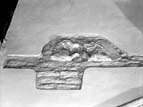Select a site alphabetically from the choices shown in the box below. Alternatively, browse sculptural examples using the Forward/Back buttons.
Chapters for this volume, along with copies of original in-text images, are available here.
Object type: Fragment, possibly reused as part of a frieze
Measurements: Too high to measure, but recorded by Taylor and Taylor (1963a, 17) as: H. c. 38 cm (15 in); W. c. 60 cm (30 in); D. of relief c. 60 cm (2.25 in)
Stone type: Unobtainable
Plate numbers in printed volume: Pl. 444
Corpus volume reference: Vol 7 p. 215
(There may be more views or larger images available for this item. Click on the thumbnail image to view.)
This description is based partly on what was visible from below and partly on the Taylors' observations from scaffolding.
Two affronted beasts in high relief, each on a separate stone. The shape of the stones is not as clear today as when Taylor (1963, 161, fig. 2b) drew them before the wall was mortared, but the shape of the background stone on the left does not look the same as in his drawing. Only the upper part of each body survives, and the beasts appear to have been cut down but placed in a meaningful position with heads facing and front paws raised as if in combat. They have gaping jaws with prominent teeth, shaggy manes, and long clawed feet.
These stone do appear to be insertions into the wall, and this is one of the suggestions made by the Taylors (1965, I, 183) to account for the fact that they have not been cut by the rebate for the roof plate. On the other hand they are neatly placed on the string course, and if they are Roman, as has been suggested for Cricklade 4 (below), then they could have been placed in the wall when it was constructed. They have, as Taylor also noted (1963, 168, fig. 2a–b), some similarities with the pair of beasts at Somerford Keynes, Gloucestershire, which are convincingly Anglo-Saxon (Bryant and Viner 1999, 155–8, fig. 1), but the Cricklade animals are less stylised thanthose at Somerford. These animals look as though they have been cut down from more complete forms, and so have little affinity with the more anonymous beast heads with closed mouths which are found as label stops at Deerhurst and Gloucester, and which have been dated to the late ninth and late eleventh century respectively (Gem 1993, 53, pl. VIIIb–d; Heighway 1980, 215, pl. XXIIb). They have apparently no specific Anglo-Saxon or Romanesque characteristics, and although the realistic fighting posture could be seen as more typical of Roman art they have not been claimed by Roman archaeologists who have surveyed this region (Cunliffe and Fulford 1982). It should be remembered that there was considerable interest in wild and exotic animals in late Saxon literature and art (see Melbury Bubb, Dorset, p. 104; also manuscript illustrations of the 'Marvels of the East' and Herbaria (Temple 1976, ills. 185, 188)), and it is possible that these creatures were another example of this interest.



